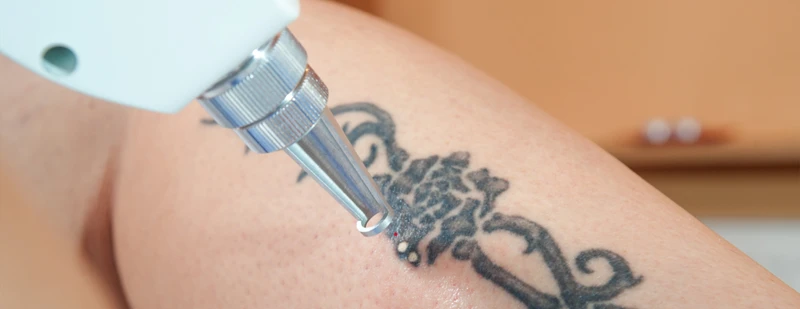Do you want to get rid of that tattoo you regret getting? If so, you may be wondering what type of laser is used for tattoo removal. Tattoo removal laser treatments require the right laser to be effective and safe. In this article, you’ll learn about choosing the right laser for tattoo removal so you can safely and effectively get rid of your unwanted ink.
Contents
Types of Lasers Used for Tattoo Removal

Q-Switched Laser
Q-Switched lasers are the most popular and widely used lasers for tattoo removal. These lasers produce short pulses of powerful energy that break down the ink particles in the tattoo. Q-Switched lasers are highly effective for removing all colors of tattoo ink and are the gold standard for tattoo removal.
Picosecond Laser
Picosecond lasers are the newest type of lasers used for tattoo removal. They produce ultra-short pulses of energy that break up the ink particles more quickly than Q-Switched lasers. Picosecond lasers are particularly effective for removing dark inks such as black and blue.
Nd:YAG Laser
Nd:YAG lasers are the most powerful type of laser for tattoo removal. These lasers produce long pulses of energy that can penetrate deeper into the skin and break down the ink particles. Nd:YAG lasers are best for removing stubborn, resistant inks such as green and yellow.
Choosing the right laser for removing a tattoo depends on a variety of factors, including the size, color, and location of the tattoo. A qualified and experienced laser technician can determine what type of laser is best for a particular tattoo.
Factors to Consider When Choosing a Laser for Tattoo Removal

Skin Color
The type of laser used for tattoo removal should be chosen based on the patient’s skin color. Different lasers are better suited for different skin tones, with some lasers being more effective on lighter skin and others being more effective on darker skin.
Skin Type
The skin type of the patient is also an important factor to consider when choosing a laser for tattoo removal. Lasers with shorter wavelengths are better suited for people with darker skin, while lasers with longer wavelengths are better for people with lighter skin.
Tattoo Color
The color of the tattoo is another important factor when selecting a laser for tattoo removal. Different lasers are better suited for different colors, with some being better for black tattoos and others being better for colored tattoos.
Tattoo Depth
The depth of the tattoo is also an important factor to consider when choosing a laser for tattoo removal. Different lasers are better suited for tattoos that are at different depths in the skin, so it is important to know the depth of the tattoo in order to choose the right laser.
Tattoo Age
The age of the tattoo is also an important factor to consider when choosing a laser for tattoo removal. Lasers with different wavelengths are better suited for tattoos of different ages, so it is important to know the age of the tattoo in order to choose the right laser.
Tattoo Location
The location of the tattoo is also a factor to consider when choosing a laser for tattoo removal. Different lasers are better suited for tattoos in different locations, so it is important to know the location of the tattoo in order to choose the right laser.
Potential Side Effects of Laser Tattoo Removal
Scarring
The most common side effect of laser tattoo removal is scarring. Laser treatments can damage the skin and cause scarring, which can be permanent and difficult to treat.
Blistering
Laser tattoo removal can also cause blistering of the skin. Blisters can be uncomfortable and can lead to infection if left untreated.
Pigment Changes
Pigment changes can also occur with laser tattoo removal. The laser can cause hypopigmentation (loss of skin color) or hyperpigmentation (darkening of the skin).
Pain
Laser tattoo removal can be painful. Pain medications and numbing agents can be used to reduce the discomfort.
Infection
Infection is another potential side effect of laser tattoo removal. It is important to keep the treated area clean to reduce the risk of infection.
Swelling
Swelling is a common side effect of laser tattoo removal. It can be managed with cold compresses and over-the-counter pain medications.
Frequently Asked Questions
What is the Most Effective Laser for Tattoo Removal?
Q-switched Nd:YAG Laser is the most effective laser for tattoo removal. It is considered the gold standard for tattoo removal due to its high efficiency and safety profile. Here are some of its benefits:
- Highly effective in removing all colors of tattoos, including difficult-to-remove blues and greens.
- Able to target deeper layers of skin for complete removal.
- Treats a wide range of tattoo sizes.
- Minimizes the risk of scarring and other side effects.
- Allows for quick and painless treatments.
Q-switched Nd:YAG lasers are known to be the most effective and safest laser for tattoo removal. Patients can expect good results with minimal risk of scarring or other side effects.
Does the Color of the Tattoo Affect the Success of Laser Tattoo Removal?
The color of the tattoo plays an important role in the success of laser tattoo removal. Different laser wavelengths are better suited for different tattoo colors. For example, black and dark blue tattoos respond best to a 1064nm wavelength laser, while red, orange, and yellow tattoos respond best to a 532nm wavelength laser. Additionally, tattoos with multiple colors may require different lasers to target each color. Therefore, it is important to consider the color of the tattoo when selecting the laser for tattoo removal.
What are the Risks and Side Effects Associated with Laser Tattoo Removal?
Common side effects of laser tattoo removal include temporary pain and discomfort, skin discoloration, swelling, and blistering. There is also a risk of scarring or the possibility that the tattoo will not be completely removed. People with darker skin tones may experience more discoloration and pigmentation changes due to the laser. The risk of infection is also present, so it is important to follow all instructions for post-treatment care.
It is important to note that laser tattoo removal is a medical procedure and should be performed by trained professionals in a safe and sterile environment.
How Many Treatments Are Required for Complete Tattoo Removal?
The number of treatments needed for a complete tattoo removal can vary from person to person. Factors such as skin type, size, color, depth, and age of the tattoo can all influence the number of treatments required. On average, most tattoos require 4-6 laser treatments for complete removal. However, some tattoos may require more or fewer treatments. Additionally, the type of laser used can also affect the number of treatments needed. It is important to consult with a medical professional to determine the best laser type and number of treatments needed to achieve the desired results.
Is there any downtime associated with laser tattoo removal?
Yes, there is usually some downtime associated with laser tattoo removal. Depending on the type of laser used, there may be some redness, swelling, and blistering at the treatment site that can last for a few days. In some cases, the treated area may become infected, so it is important to follow any aftercare instructions provided by the treating doctor. It is also important to avoid direct sun exposure and to use a sunscreen with a minimum SPF of 30 on the treated area for several weeks following the procedure.
Conclusion
Tattoo removal can be a long and difficult process. Choosing the right laser for the job is essential to ensure the best possible outcome. Q-switched lasers are the most popular choice, as they provide effective, safe, and efficient tattoo removal. However, other laser types may be suitable for specific cases, depending on the size, color, and depth of the tattoo. Consulting a professional is the best way to determine the best laser for each tattoo removal situation.